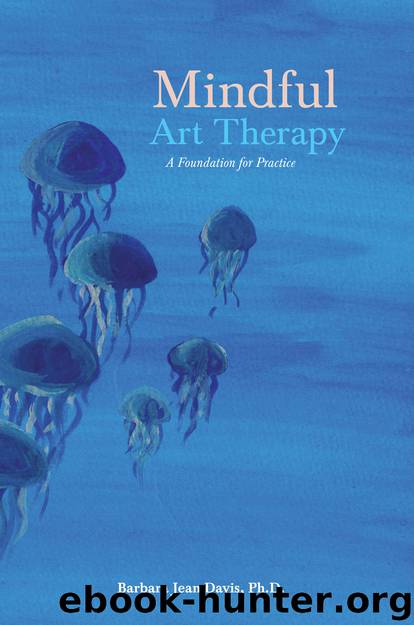Mindful Art Therapy by Davis Barbara Jean;

Author:Davis, Barbara Jean;
Language: eng
Format: epub
ISBN: 9780857007919
Publisher: Jessica Kingsley Publishers
Published: 2015-05-29T16:00:00+00:00
CHAPTER 8
Voice of Reason
Early on in my psychology career, a supervisor explained anger as the flip side of depression. This was her educated hunch, based on several decades of experience. It has led me to ponder the idea ever since. Anger is a normal human emotion, which, if managed properly, seldom leads to any harm. In times of need, it serves to defend oneself or prevent oneself from being taken advantage of. Being angry is one experience—being an angry person, quite another. When anger is suppressed, it can bubble under the surface and contribute to an ongoing narrative that drives behavior.
Although coherent narratives help us make sense of our lives (Kashdin and Ciarrochi), they can also keep us stuck. As one learns to encounter the narrative mindfully, the shift from striving to “make things right,” to accepting “how things are,” can be freeing. While it is sometimes difficult for clients to confront strong emotions head on, mindful art therapy offers mental distance to explore the personal narrative in a non-threatening way. Gaining mental distance also enables a client to separate him- or herself from the conceptual meaning of emotions such as anger, and grasp its deeper meaning. Furthermore, in contrast to logically reasoning through it, mindful reflection on artworks can help a client to reappraise their life story and begin to change their relationship to it.
Max
Max, a 30-year-old male, came to therapy to explore his depression and anger. In the typically stoic manner in which he was raised, tears were there but difficult to access. Having recently and unexpectedly lost his mother, sadness gave way to an enduring sense of depression that he said had begun several years earlier. At the time, feelings of regret for not having been kinder to his mother were brewing under the surface. As we worked mindfully through the grieving process, Max began to acknowledge his difficulty connecting with emotions, and particularly in managing his anger.
Anger was something Max had experienced all of his life in various ways of lashing out. Beyond classic sparks of embodied anger that resulted in flying off the handle, yelling, and fistfights, Max reflected that rage seemed be common in the males in his family. For example, he recalled how his father used to go out in the shed and bang things around when he was angry, or when he himself yelled at others. He also recollected how his six-year-old nephew, who despite minimal contact with Max or his father, flew into fits of rage (balling his fists, narrowing his eyes, silently fuming) when he didn’t get his own way. Whereas these insights might previously have spurred helplessness, ambivalence or resignation, reflecting on the temperamental nature of males in his family helped Max take it in without judging it.
Download
This site does not store any files on its server. We only index and link to content provided by other sites. Please contact the content providers to delete copyright contents if any and email us, we'll remove relevant links or contents immediately.
The Art of Thinking Clearly by Rolf Dobelli(9908)
The 5 Love Languages: The Secret to Love That Lasts by Gary Chapman(9273)
Mindhunter: Inside the FBI's Elite Serial Crime Unit by John E. Douglas & Mark Olshaker(8697)
Becoming Supernatural by Dr. Joe Dispenza(7831)
The Road Less Traveled by M. Scott Peck(7274)
Nudge - Improving Decisions about Health, Wealth, and Happiness by Thaler Sunstein(7238)
Mastermind: How to Think Like Sherlock Holmes by Maria Konnikova(6936)
Enlightenment Now: The Case for Reason, Science, Humanism, and Progress by Steven Pinker(6869)
Win Bigly by Scott Adams(6823)
The Way of Zen by Alan W. Watts(6288)
Factfulness: Ten Reasons We're Wrong About the World – and Why Things Are Better Than You Think by Hans Rosling(4486)
The State of Affairs by Esther Perel(4483)
Gerald's Game by Stephen King(4371)
Man's Search for Meaning by Viktor Frankl(4266)
The Confidence Code by Katty Kay(4033)
Thinking in Bets by Annie Duke(3995)
The Worm at the Core by Sheldon Solomon(3325)
Hidden Persuasion: 33 psychological influence techniques in advertising by Marc Andrews & Matthijs van Leeuwen & Rick van Baaren(3290)
Enlightenment Now by Steven Pinker(3271)
